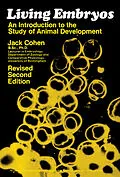Living Embryos: An Introduction to the Study of Animal Development, Revised Second Edition presents the processes of development as seen throughout the animal kingdom. This book discusses the development of the organ systems of vertebrates.
Comprised of 41 chapters, this edition starts with an overview of the history of the study of embryology, which is concerned with the process by which the adult arises from the fertilized egg. This text then discusses the role of the sperm in the determination of bilateral symmetry. Other chapters consider the development of the frog in order to give a basis for comparison with other species. This book discusses as well the structure of the hen's egg and illustrates the various stages of the development of the chick. The final chapter deals with animal evolution, which produces a wide variety of animal forms.
Embryologists, zoologists, medical students, graduate students, university lecturers, and teachers will find this book extremely useful.
Inhalt
Preface
Introduction
The Gametes
Fertilization
Cleavage and Organization of the Egg
Cleavage and the Blastocoele
Gastrulation
Presumptive or Fate Maps
Germ Layers
The Early Embryology of the Frog
Nematodes
Polychaetes
Molluscs
Arthropods
Echinoderms
Tunicates
Vertebrate Embryology-Preamble
Development of Fishes
Development of the Chick
Comparisons and Mechanisms in Early Vertebrate Development
The Sequence of Developmental Events
Embryonic Membranes
The Development of Mammals
The Rabbit
Early Development of Other Mammals
Early Human Development
Development of Organ Systems
The Heart and Vascular System
The Alimentary System
The Nervous System
The Muscular System
The Neural Crest
The Skin
Sense Organs-Preamble
The Eye
The Ear
The Nasal Organ
The Endocrine Glands
The Urinogenital System
Cell Differentiation
Metamorphosis
Embryos and Evolution
Appendix I-Sources of Material
Appendix II-Methods
Appendix III-Further Reading
Appendix IV-Films
Index
